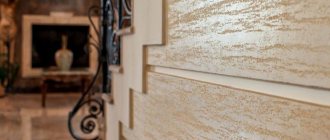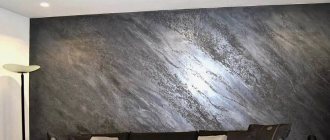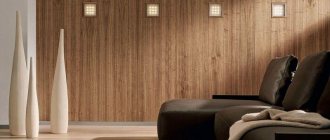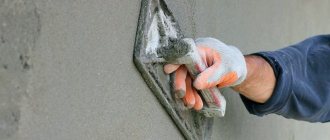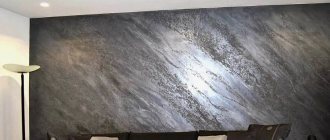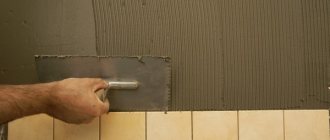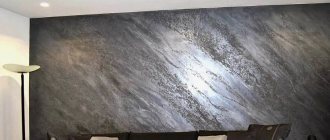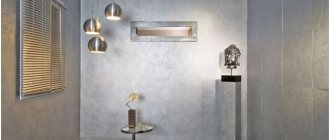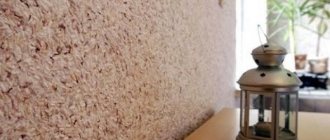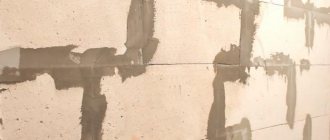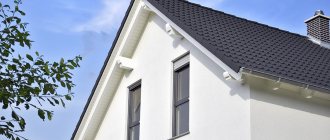The spectacular texture of Roman stone is imitated by decorative travertine plaster, which can be used to easily decorate any interior. Travertine is a fine-grained calcareous tuff (a rock form intermediate between marble and limestone) that can be easily sanded and polished. Thanks to its beauty and “obedience,” the stone was widely used already in ancient times. It was called travertino or stone from Tibur. It is characterized by its sponginess and porous structure.
What is travertine
Travertine is a mineral formation that, according to classification, occupies an intermediate place between marble and limestone formations. From the latter, the stone inherited durability and strength. At the same time, the mineral can be easily processed, like limestone. But compared to marble, the cost of mining and transporting travertine is much cheaper.
This intermediate link between rocks can be described as “immature, unfulfilled marble.” Visually, the stone is similar to calcareous rocks. The mesh structure of the rock, riddled with micro-holes and tiny cracks, does not allow it to be used as a material for creating monolithic monuments and sculptures. A peculiar pattern is visible on the saw cuts, which emphasizes the individuality of the natural material.
The density of the rock has a direct effect on the shades. If travertine is of a light shade (beige, walnut), then the density is low. If the color is rich (dark red, burgundy, brown), then the rock is dense.
Properties of travertine
The structure in the form of cells is the main difference between the material and calcareous rock.
Travertine is characterized by low hardness and low density. The porosity of the structure provides travertine with good thermal properties and sound absorption. At the same time, travetin is one of the lightest natural stones; it is much more durable than marble, granite and limestone. Relatively high water permeability does not prevent the material from being durable, frost-resistant, and resistant to external influences.
The most important characteristics of travertine:
- material density ranging from 2.5 to 2.7 g/ms3;
- degree of porosity about 8.2%;
- strength properties under compression within 47 MPa;
- water absorption – 1.7%
- the hardness of the material on the Mohs scale is 4 units;
- softening (coefficient) – 0.81.
All of the listed characteristics are inherent in a sample with average properties. But, depending on the impurities of various minerals, the characteristics may differ slightly.
Mixture consumption and popular manufacturers
The thickness of the applied plaster is small. Therefore, material consumption is usually small - on average only 1.5-2 kg/m2. The consumption of the mixture depends on the recipe, coating technique and level of skill. For an accurate calculation, you can use our online decorative plaster calculator.
Textured travertine mixtures, ready-made or in powder form, are produced by many manufacturers:
- Travertino (Russian manufacturer Wowcolor),
- Calce Antica a Spatola (Italian company J COLORS SpA),
- Travertinus (Italian producer Adicolor),
- Verona (Russian manufacturer),
- Decorazza Traverta (Russian holding Interra Deco Group),
- Marmo Antiko and Intonachino Minerale (Italian manufacturer San Marco),
- Traverto Sol (Russian company MascaradE),
- Jazz travertino (Italian manufacturer Colorifico Sammarinese),
- Travertino Clavel (French company Clavel),
- Roman stone (Russian company Optimist-elite), etc.
Do-it-yourself decorative plaster is not only a “bark beetle” or a “fur coat”, but also more complex imitations. Dress your home in Romano travertine and you will feel like you are at the crossroads of times and on the crest of progress.
Composition of travertine, minerals
The main minerals in travertine are aragonite with small additions of calcite.
Travertine is characterized by the presence of calcium oxide, which can account for up to half of all other minerals and substances. Another 5% comes from silicon dioxide. The rest consists of various chemical elements and their derivatives. These include oxides of titanium, iron, aluminum, magnesium, and other components.
As such, travertine is considered to be calcium salts that have precipitated. It was formed at one time on the bottom sediments of reservoirs near the outlet of springs to the surface. In this case, the temperature of the water played a big role, whether it was warm or cold. This factor influences the quality and properties of the rock.
The quality of the final product (travertine) is influenced by several factors. Properties depend on:
- temperature regime of water and atmosphere;
- CO2 content in solution;
- luminous flux intensity;
- flow turbulence.
The porosity of the material is determined during the formation process, due to the connection with sulfur dioxide gases, particles of which rose from the depths, passing through layers of calcareous rocks, mixing with them. The frequency of pores depends on the amount of different biological material that participated in the process of rock deposition. These can be shells of microorganisms, leaves, twigs, blades of grass, flowers, animal bones.
In calm water that does not have channels, solid stones of good quality are formed. If the place of formation is characterized by turbulent currents, near waterfalls, rapids, then stones with a spongy structure are obtained.
The conditions of the precipitation processes of calcium carbonates have a great influence on color. In the absence of large external loads and influences, the colors will be closer to whitish and light. But such stones can be found extremely rarely in nature. Basically, yellowish samples are mined, beige with various shades.
Dark-colored travertines have a higher resistance to stress, they are more durable and monolithic. When mined, stones can change both color and quality. For example, white travertine may turn yellow or sandy when brought to the surface. This phenomenon occurs due to the oxidation of salts of certain metals that make up the stone.
Travertine mining
The development of travertine deposits is associated with the peculiarities of the rock occurrence. As a rule, deposits are located in the bottom areas of reservoirs where carbon dioxide is present. Most often these are deep caves and karsts. Here, carbon dioxide is mixed with water and deposited as calcium carbonate particles. At this place you can observe stalactites and stalagmites. While the material hardens, carbon dioxide particles penetrate into its mass, forming tiny pores.
Among the richest deposits of rare material are the mines in Italy. On the territory of the former Soviet republics, it is mined in the regions of Tajikistan, the South Caucasus, and in the deposits of Kyrgyzstan. In Tivoli, travertine deposits have not dried up until our time. In Russia, the rock is mined in the deposits of Kamchatka and Pyatigorsk. The most famous variety of stone is developed in Turkey. The mine is located in the famous Pamukkale. Here, over many thousands of years, magnificent flooded terraces have formed.
Use of travertine
Most buildings and structures made of travertine can be found in Italy. In the city of Tivoli (formerly Sibur) there are rich deposits of amazing stone. For many centuries, thanks to the strength of the local type of travertine and its durability, the foundations of houses were assembled from stone, buildings and structures were erected.
It is noteworthy that natural material became the most popular in the construction of temples. For example, the main building material of St. Peter's Cathedral in the Vatican (the same one where the Pope himself leads masses) is travertine from Tivoli. The Sacré-Coeur Basilica, located on top of Montmartre at the highest point in Paris, is also made of travertine.
In addition to religious buildings, the material was widely used in civil engineering, in the construction of engineering structures - bridge floors, viaducts, etc. By the way, the first bridge in Rome was built from this unique stone. The structure is still in operation, pleasing to the eye and serves as a reliable overpass. The Roman square Piazza Navona is paved with travertine, and travertine was also used to create the well-known Trevi Fountain.
Due to its porosity, travertine is not afraid of fire and high temperatures. It is for this reason that stone was widely used in the construction of residential buildings, administrative and other buildings of the ancient Romans. In ancient times, fires occurred quite often, and the rock did not allow the fire to spread in urban areas. Externally, buildings made of travertine do not look flashy, restrained and modest.
Renaissance architects used this rock stone as a component of plaster.
Nowadays, builders and architects pay close attention to this amazing building material. The famous stadium in Barcelona, Spain, and the world center in Los Angeles, America were lined with travertine.
In our country, stone has found demand in the decoration of some metro stations in St. Petersburg, and in the decoration of the Kazan Cathedral.
In the capital, stone was used in the construction of the ITAR-TASS center. And in the city of Grozny, travertine was used in the construction and decoration of the main mosque “Heart of Chechnya”.
Features of application
To create the exterior (external decoration of buildings), it is preferable to use artificial analogues. In earlier times, natural travertine was used to decorate today's architectural monuments. Proper care and consideration of external conditions will help preserve the beauty and structure of the mineral. Despite its susceptibility to high humidity, the breed is suitable for finishing a bathroom (tiles of their breed). Decorating the walls and floors in the guest rooms and hall will create an airy, light space.
The material is often used in kitchens and dining rooms. Despite the size of the room and its purpose, travertine creates an atmosphere of unpretentious luxury and aristocratic comfort.
Travertine in the interior
This stone has not only useful properties, but also a spectacular appearance. Thanks to this, travertine has found wide application in decoration, decoration and interior design. Its decorative qualities put it in one of the first places among other natural stones. The most common tiles are yellowish shades. Material of other colors is less common and costs more. Travertine has become widespread and has gained popularity due to its similarity with marble, but at the same time it is much “warmer” and “cozier”.
It so happened that, due to its yellowish color and numerous veins, travertine is often used to decorate the interior of bathrooms and toilet rooms. Yellow and beige shades give warmth and a sense of calm to the eye. The texture of the stone does not require complex processing. Sometimes white travertine is left in its original form without sanding at all. Other colors are polished to leave a natural pattern and texture.
The pattern of travertine directly depends on the direction of sawing the stone block into slabs.
- if the sawing is done lengthwise along the veins, the stone is called Vein Cut. Its texture is distinctly banded; At first glance, this finish resembles wood. Designers and customers highly value this design.
- if the sawing was done across the veins, such travertine is called Cross Cut. It is characterized by a patterned, heterogeneous pattern.
Raw, unpolished travertine gives an atmosphere of luxury, cozy home, and durability. For travertine there is no concept of “temporary”. The stone gives a feeling of reliability and eternity. The stone is unpretentious, but it has its “weaknesses”. Like any other carbonate rock, travertine is sensitive to acid attack. Under the influence of vinegar or a caustic household product, the stone is slightly corroded.
Just try to keep the stone clean, and use detergents with neutral PH for cleaning. Don’t forget about preventive care of the stone: every six months, treat your product with a special water-repellent impregnation, which will create a protective barrier on the surface.
Advantages and disadvantages
Imitating the surface of natural stone, travertine decorative plaster comes close to it in other respects.
She has:
- good strength,
- aesthetic appeal,
- environmental friendliness,
- steam conductivity,
- moisture resistance,
- fire safety,
- good adhesiveness,
- good resistance to biological damage,
- resistance to aggressive substances,
- versatility of application techniques,
- maintainability,
- easy to paint without losing its texture,
- richness of color mixtures,
- ease of care,
- versatility.
Some disadvantages of plaster were:
- high price of compounds,
Types of mixtures
You can cover the walls of your house in travertine without buying natural stone. To do this, it is enough to use plaster compositions and techniques for simulating the texture of travertine. Fortunately, there are enough materials for this.
For simulation you can use:
- ready-made Travertino mixture, which includes sand, lime dough and marble chips;
- dry mixture Liquid travertine, the components of which are polymer binder and fine travertine chips (the composition is diluted with the volume of water indicated on the packaging). Liquid travertine is 92% natural Roman stone;
- cement-sand plasters with white cement, to which you need to add dye (you can prepare it yourself, then the coating will be cheap);
- putties or gypsum plasters (sand and pigment are added to them).
Any type of plaster is suitable for travertino, except silicate, roller, pebble and flock.
Photos of travertine
Below you can see some photos of travertine in various applications. Facades, wall decoration, paving, etc.
Main and auxiliary tools
There are several techniques for applying travertine. Below are the supplies and tools you may need:
- Trowel-trowel (must have rounded corners),
- spatulas,
- gun for applying the solution (hopper),
- hard brush,
- brush (for varnishing or trimming),
- Sander,
- rollers,
- masking tape,
- level, ruler for marking,
- containers,
- mixer,
- sandpaper,
- clean rags.
